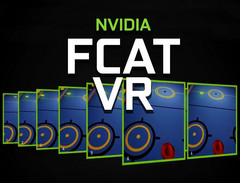Testing a VR game's performance isn't as simple as enabling FRAPS and periodically checking the FPS counter. Various factors besides frame rate help to determine whether you are getting an optimal VR experience. Until today, a combination of benchmarking tools and synthetic tests had to be used individually to analyze these factors. Nvidia's new FCAT VR performance analysis tool finally addresses that inconvenience, and it is available for free.
According to the tool's guide, the FCAT VR reads data from Nvidia driver stats and the Oculus Rift or HTC Vive (depending on which headset you are using) to "generate precise VR performance data" on your GPU. Users can then analyze that data to examine frame times and check for dropped frames as well as synthesized frames—such as those created via the Rift's asynchronous spacewarp technique—to get a better idea of the experience that the tested GPU is providing.
Nvidia's FCAT VR guide goes into great detail explaining each aspect of the tool, including installation, use, and how to interpret the data generated during testing. It also features separate sections for the Oculus Rift and HTC Vive, and a list of recommended games for first-time testing. In addition, a large portion of the guide features information on related VR topics and is meant for developers, so those interested only in running tests can ignore it.






